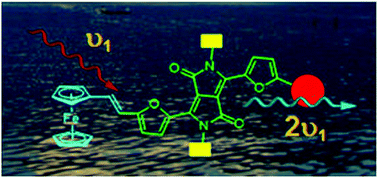Synthesis, characterization and second-order nonlinear optical behaviour of ferrocene–diketopyrrolopyrrole dyads: the effect of alkene vs. alkyne linkers†
Abstract
New, thermally stable dipolar ferrocene–diketopyrrolopyrrole (Fc–DPP) dyads with alkene as a linker exhibited structure dependent first hyperpolarizabilities, βHRS, recorded by a femtosecond HRS technique using a femtosecond (120 fs) pulsed laser light system at 900 nm at ambient temperature. On the basis of linear optical, electrochemical and TD-DFT studies, a good structure–polarization relationship has been established to account for the observed trends in first hyperpolarizabilities. The dyads exhibited fluctuating but matching solvatochromism. Nonlinear optical properties are modulated both by the strength of the acceptor as well as the length and nature of the π-conjugation bridge. βHRS of the dyads were compared with structurally related dyads in which the DPP core and the Fc donor are linked via an alkyne bridge. It is interesting to observe that the replacement of an alkyne link with alkene in these D–π–A chromophores does not necessarily furnish enhanced βHRS.



 Please wait while we load your content...
Please wait while we load your content...